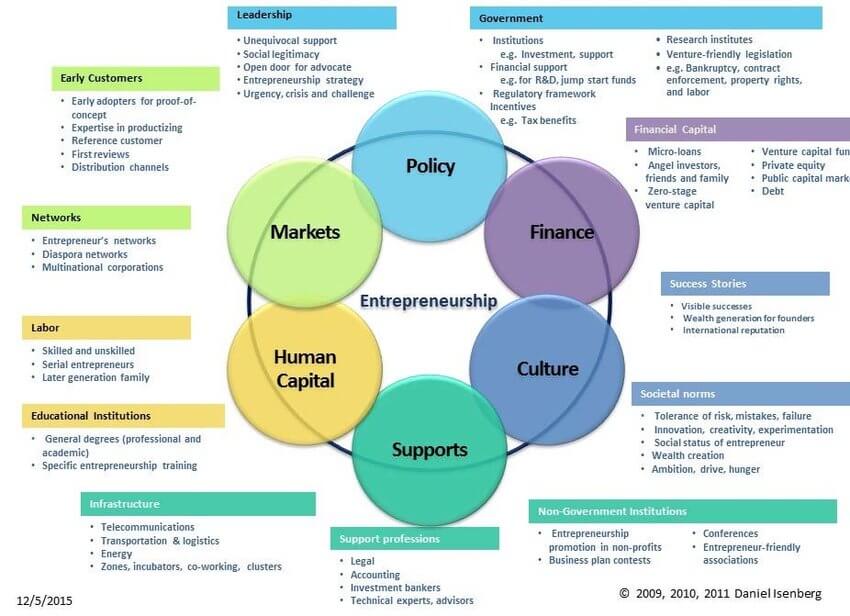What are Entrepreneurial Ecosystems?
The Education Collaborative at Ashesi University has started an initiative to develop and strengthen the African higher education institutions (HEIs) entrepreneurship ecosystems. The Entrepreneurship Ecosystem Project aims to explore, share and implement best practices for entrepreneurship ecosystem development on HEI campuses in Africa, learning from thriving ecosystems on the continent.
Led by Dr Sena Agbodjah Agyepong, Head of Business Administration, Ashesi University, and co-led by Dr William Murithi, Adjunct Faculty, Ashesi University, the project team will identify ten to fifteen exemplar institutions in Southern, Central, Eastern and Western Sub-regions in Africa to develop cases with sustainable ecosystems that support student-centred entrepreneurial activities. They will then identify four institutional mentors from each region and pair them with four institutional mentees for a one-year mentorship program. By bringing partner institutions together, the Entrepreneurship Ecosystem Project aims to build and grow an entrepreneurship ecosystems community of practice and contribute to a framework that will guide HEIs and other stakeholders on entrepreneurship education in Sub-Saharan Africa.
Daniel Isenberg, a Professor of Entrepreneurship Practice at Babson College, who established the Babson Entrepreneurship Ecosystem Project, argues that the four characteristics of the Entrepreneurship Ecosystems are;
- The entrepreneurship ecosystem consists of six domains.
- Each ecosystem is unique: no two-entrepreneurship ecosystems are the same despite having the six domains represented.
- Specifying generic root causes of the entrepreneurship ecosystem has limited practical value.
- Entrepreneurship ecosystems become (relatively) self-sustaining.
Additionally, Daniel Isenberg stated that the entrepreneurship ecosystem consists of hundreds of specific elements that he groups into six general domains: “a conducive culture, enabling policies and leadership, availability of appropriate finance, quality human capital, venture-friendly markets for products, and a range of instructional and infrastructural supports”. The entrepreneurship ecosystems diagram produced by Isenberg below shows the six domains with fifty specific components.

Every entrepreneurship ecosystem is different. Although the six domains can define each ecosystem, Isenberg argues that the ecosystem is a “result of the hundreds of elements interacting in highly complex and idiosyncratic ways”. Hence, regional ecosystems should be complementary to their contextually diverse factors.
Whereas research has demonstrated that regulatory, education and legal frameworks and well-functioning capital markets impact the level of entrepreneurship within the society, Isenberg argues that this will take effect over a long period and appear to be weak.
Thus, the need to establish a generic root cause of the entrepreneurship ecosystem has limited practical value. To enhance entrepreneurship ecosystem outcomes and impact, we must endeavour to access and unpack entrepreneurship ecosystems to understand their structures, catalysts, and prospects.
Finally, when entrepreneurship ecosystems become successful, they tend to be mutually self-sustaining. With time, the success witnessed within the ecosystems feedback to the six domains. Therefore, Isenberg argues that government policy interventions need to be significantly reduced with time. Once the six domains are strong enough, they tend to be self-reinforcing, and government support is not required to sustain them.
How do Entrepreneurial Ecosystems come to be? Do they evolve naturally, or can we intelligently design them?
According to Isenberg, the Entrepreneurship Ecosystem is a result of an intelligent evolution, a process that blends the invisible hand of markets and the deliberate helping hand of public leadership that is enlightened enough to know when and how to lead as well as let go of the grip to cultivate and ensure (relative) self-sustainability. Therefore, as we work to create an entrepreneurial society, we must endeavour to develop self-sustaining entrepreneurship ecosystems.
The entrepreneurship ecosystem project aims to develop a playbook that will unpack the process of developing Entrepreneurship Ecosystems and act as a map to enable African higher education institutions to develop and enhance their entrepreneurship ecosystems.
References
Isenberg, D ( 2011) Introducing the entrepreneurship Ecosystems: Four Defining characteristics, available from https://www.forbes.com/sites/danisenberg/2011/05/25/introducing-the-entrepreneurship-ecosystem-four-defining-characteristics/?sh=36ab4f9c5fe8 accessed 4th March 2022.
Isenberg, D (2011) President Obama can make start-up America Succeed. Access from https://hbr.org/2011/02/dear-president-obama-how-to-ma on 5th March 2022.



